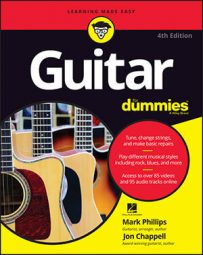A guitar isn't limited by what it's made of any more than a sculpture is. Don't judge a guitar only by its materials, but consider that a guitar with better materials (abalone inlays as opposed to plastic ones) tends to have commensurately better workmanship — and is, therefore, a better guitar — than a model that uses inexpensive materials. Some important guitar materials to consider:
Guitars made of woods
As you may expect, the more expensive or rare a wood, the more expensive the guitar you construct from that wood. Guitar makers break woods down into categories, and each category has a bearing on the guitar's overall expense.
Following are the three criteria used for classifying wood:
Type: This category simply determines whether a piece of wood is mahogany, maple, or rosewood. Rosewood tends to be the most expensive wood used in the construction of acoustic-guitar bodies, followed by maple and then mahogany.
Style: You can classify woods further by looking at the wood's region or grain style. For example, the figured maples, such as quilted and flame, are more expensive than rock or bird's-eye maples.
Grade: Guitar makers use a grading system, from A to AAA (the highest), to evaluate woods based on grain, color, and consistency. High-quality guitars get the highest-grade wood.
Hardware on guitars
In more expensive instruments, you see upgrades on all components, including the hardware, or the metal parts of the guitar. Chrome-plated hardware is usually the cheapest, so if you begin looking at more expensive guitars, you start to see gold-plated and black-matte-finished knobs, switches, and tuning machines in place of chrome.
The actual hardware the manufacturer uses — not just the finishes on it — changes, too, on more expensive instruments. High-quality, name-brand hardware often replaces the guitar maker's less prestigious, generic brand of hardware on high-end axes. For example, manufacturers may use a higher-grade product for the tuning machines on an upscale guitar — such as locking Sperzels (a popular third-party tuner type and brand), which lock the string in place as opposed to forcing the user to tie the string off at the post.
The bridge is an important upgrade area as well. The so-called floating bridge (so designated because you can move it up and down by means of the whammy bar) is a complicated affair of springs, fine-tuning knobs, and anchors. The better floating assemblies, such as the Floyd Rose system or systems manufactured under a Floyd Rose license, operate much more smoothly and reliably than do the simple three-spring varieties found on low-cost guitars. (The strings spring right back to pitch on a Floyd Rose system, even after the most torturous whammy bar abuse.)
Pickups and electronics
Unless a guitar manufacturer is also known for making great pickups, you see more and more use of third-party pickups as you go up the quality ladder. In the electric arena, Seymour Duncan, DiMarzio, Bartolini, Bill Lawrence, Lace and EMG are examples of high-quality pickup brands that guitar makers piggy-back onto their models. Fishman and L.R. Baggs are two popular acoustic pickup systems found on many well-known guitars.
Although they're not known by name brands, the electronics in electric guitars also improve along with the other components as you venture into more expensive territory. You can see a greater variety, for example, in pickup manipulation. Manufacturers can provide circuitry that changes double-coil, or humbucker, pickups into single-coils, enabling them to emulate the behavior of Stratlike pickups. Having one guitar that can imitate the pickup behavior of other guitar types provides you with a tonally versatile instrument. You also see more manipulation in wiring schemes. For example, guitar makers may reverse the polarity of a pickup — the direction the signal flows — to make the guitar sound softer and swirlier.
With more expensive guitars, you may also encounter improved volume and tone controls, resulting in better taper. Taper is the gradualness or abruptness of change (also called response) of a signal's characteristics (in this case, volume and tone) as you turn a knob from its minimum value to its maximum. A knob exhibiting a smoother taper is evidence of a higher grade of electronics. Really cheap guitars give you no sound at all until turned up to 3; then you get a swell of sound from about 4 to about 7 and no change at all between 7 and the knob's maximum value, 10 — or, on those really rare, loud guitars, 11. (And if you don't get that last joke, watch the hilarious rockumentary spoof This Is Spinal Tap. It's required viewing for all guitarists.)

